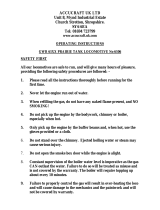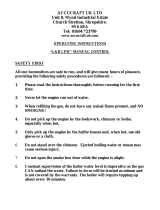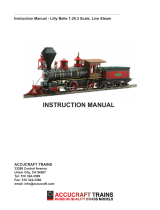Page is loading ...

ACCUCRAFT UK LTD
Unit 4, Long Meadow Industrial Estate
Pontrilas, Herefordshire, HR2 0UA
Tel: 01981 241380
www.accucraft.uk.com
OPERATING INSTRUCTIONS
ACCUCRAFT ⅞ SCALE 7 x 12 INCH BAGNALL
SAFETY FIRST
All our locomotives are safe to run, and will give many hours of pleasure,
providing the following safety procedures are followed: -
1. Please read the instructions thoroughly before running for the first
time.
2. Never let the engine run out of water.
3. When refilling the gas, do not have any naked flame present, and NO
SMOKING!
4. Do not pick up the engine by the bodywork, chimney or boiler,
especially when hot.
5. Only pick up the engine by the buffer beams and, when hot, use
gloves or a cloth.
6. Do not stand over the chimney. Ejected boiling water or steam may
cause serious injury.
7. Do not open the smoke box door while the engine is alight.
8. Constant supervision of the boiler water level is imperative as the gas
CAN outlast the water. Failure to do so will be treated as misuse and
is not covered by the warranty.

2
General Hints:
As with all operating machinery, whether model or full size, wear will occur. In the
model steam locomotive much can be done to help prolong its life and decrease the
amount of time required in the workshop for servicing.
Keep the engine as clean as possible, and the motion free from dirt and garden debris.
The valve gear, axles and crank pins should be oiled sparingly with light oil, e.g. “3-
in-1 Oil”. Over-oiling attracts dirt and grit, which will increase wear.
Regularly check that all screws and motion bolts are firm. Do not over-tighten, as
this strips threads and shears bolts. When filling the lubricator, always use a high
temperature steam oil; this is available from your dealer. FAILURE TO USE
THE CORRECT GRADE OF OIL CAN LEAD TO BLOCKED STEAM
PIPES, AND WILL INVALIDATE THE GUARANTEE.
When running your engine avoid excessive speed and acceleration, both will cause
premature wear in the valve gear. Prototypically, narrow gauge locomotives ran at a
speed of between 10 and 20 M.P.H., and never exceeded 25 M.P.H.
Positions of Fillers and Drains etc.
The gas inlet valve is in the small turret situated in the cab floor to the rear of the
burner. Use an extended gas adaptor on a 45 degree angle to fill the tank. The gas
control valve is in the rear offside of the cab and is shaped like the hand brake.
The lubricator is in the offside front of the cab, just forward of the doorway and
behind the reverse lever. The filler cap has a screwdriver slot in it to aid removal.
The lubricator drain is directly beneath the lubricator. To drain, un-screw the drain
valve through about ½ a turn.
The boiler water filler is just in front of the cab on the top of the boiler. The main
steam regulator valve is on the small turret on the back end of the boiler. Beware the
handle gets very hot!
The direction control is the lever in the right hind side of the cab, just forward of the
lubricator. To operate pull the lever gently outwards, and move to the desired
direction. The control is “gated”, and will therefore hold itself in the full forward or
reverse position.
Preparation for Running
Always service the engine in the following order; first gas, then oil, then water.
Although we recommend Butane gas, the system will also work with, and is safe for
Butane/Propane mix gas.

3
To fill the gas tank: invert the gas can and apply the nipple to the gas inlet valve. It
is advisable to support the loco under the gas tank whilst filling, to prevent the engine
tipping backwards. You will know when the tank is full; gas will blow back from the
inlet valve in a strong jet. A small amount of gas and air will escape during filling,
but the difference between this and when the tank is full is always clear. Always
keep the gas can vertical when filling the gas tank.
Filling the lubricator: As you will read in the instructions for the end of the run, the
lubricator should be empty of oil and water. Remove the lubricator filler cap. Fill up
the lubricator with steam oil to about ¼ of an inch below the top. Leave the filler cap
off for the present, so that any trapped air can escape. It can be refitted after you
have filled up the boiler.
To fill the boiler: Remove the boiler filling cap. Fill up the boiler to ¾ of the way up
the water glass – ideally use filtered rainwater or distilled water using the large
syringe provided. Replace the boiler filler cap. Now check that the lubricator does
not need topping up, and then replace its filler cap also. Filler caps should be firm
finger tight. They are sealed with a trapped ‘O’ ring and, therefore should not be
over-tightened.
If at any time the water glass gets an air bubble in it there is a blow down tap under
the footplate, under the left hand side of the cab. Take care when blowing down the
glass as very hot water will come out of the tap.
Lighting Up
Pull open the smokebox door. Light your lighter/match etc. and gently open the gas
control valve until a gentle hiss is heard in the burner. Apply your light into the
smokebox and the flame should ‘pop’ down the fire tube and ignite the burner inside
the fire tube.
If the gas valve is opened too much the flame will not pop back; it will either fail to
ignite, will roar in flame out of the smokebox, or there will be a ball of flame around
the front of the engine, which will then blow the whole fire out (after giving the
driver a fright)!
When the fire sound has stabilised, after about 30 seconds the gas can be turned up
until a gentle roar is heard. The smoke box door may be shut after about two minutes.
Now leave the locomotive to raise steam and let the locomotive raise at least 50 p.s.i.
Burner Air Control Ring
This is an adjustable air volume control which is set at the factory. However
variances in gas can give the need to either reduce or increase the air volume. To
obtain a quieter softer flame use the nut spinner supplied, and move the ring forward
slightly to reduce the air mix.

4
Running
When the engine has raised about 50 psi you are ready to start running. It is advisable
to run the engine in reverse first; it clears the condensed water from the cylinders best
this way. Before commencing your first run of the day, it is advisable to put a cloth
loosely over the chimney for a few minutes, as condensed water will be ejected from
the chimney. This is quite normal; the motion of the engine will be jerky until all
condensate has been ejected. DO NOT stand over the chimney as ejected boiling
water/steam could cause serious scalding.
Place the direction lever into the reverse position, and then open the main steam
valve. The engine should start to move off in the reverse direction. When starting
from cold it will be jerky, this is normal, as it has to clear the condensate from the
system. The more the main steam valve is opened, the faster the engine will go; our
advice is to start slowly and learn the road with your engine
After a minute or so, remove the cloth and continue running. In running it is correct
practice to balance the boiler pressure against the load being pulled and the track
conditions. With a light load and level track the pressure may need to be only 30-40
p.s.i. therefore, turn the gas control down to keep this pressure. When running a
heavy train with steep gradients, increase the pressure by turning up the gas.
The ideal running pressure can be learnt by experience and is one of the pleasures of
running a live steam engine. There is no need to have the safety valve constantly
blowing off (it is what its name implies – a safety vent for excess steam pressure).
When the gas runs out a complete gas, oil and water service must be done (remember
GOW, also remember to shut the gas regulator before refilling, and DO NOT refill
with gas near any other live steam loco).
When the locomotive slows as the pressure falls at the end of a run, stop the engine.
With the reverse lever in forward position so as to let any residual pressure in the
steam pipes escape, make sure the steam regulator is fully shut, then gently open the
lubricator drain to release the condensed water. If you intend to continue running a
complete fill of the lubricator will be required.

5
End of Run
The locomotive should be allowed to cool and all boiler pressure to go down. When
cool, gently release the water filler cap by about 2 turns to allow the boiler to have
free breathing space and not to create a vacuum as it cools. Now clean the engine,
check the motion and oil if necessary. The locomotive should always be put away in
a clean condition as it attracts less dust and is always ready for the next run (or to be
shown to an admiring friend). The lubricator drain can be opened to release any
condensed water. Always leave the lubricator and boiler filler caps loose and the
main steam valve open so that the boiler will not be strained if subject to any
temperature change. It is advisable to store the locomotive where any residual drips
of oil or water do not matter.
Blocked Gas Jets
If the gas jet becomes blocked with particles of dirt within the gas, the jet will have to
be removed and cleaned. With a spanner or pliers carefully undo the pipe union on
the gas control valve. Remove the pipe and jet holder assembly from the burner.
Holding the jet holder gently in a vice, unscrew the jet. To clear, place the jet nozzle
against the inverted gas can nozzle and clear the jet with a blast of gas. Under no
circumstances use a pricker wire, this will damage the jet hole. Replace the jet in the
jet holder, ideally using a thread sealant sparingly on the threads. Ensure it is
tightened up firmly. Replace the assembly into the burner and re-connect the pipe to
the control valve. Ensure this is done up tightly, test CAREFULLY for gas leaks,
first with a 50/50 mixture of washing up liquid and water, and then if no bubbles are
showing, with a flame and the gas “just on”. Tighten if required.
***************************************************
As with all comprehensive models, we strongly recommend a full demonstration (by
our agents) before purchase, enabling you to get the best out of your model right from
the start.
HAPPY STEAMING!

6
Identification of Controls and Fillers.
1. Steam regulator
2. Reverse lever
3. Gas regulator
4. Lubricator filler cap
5. Boiler water filler
6. Gas tank filler valve
7. Burner air control ring
8. Pressure gauge
9. Water sight glass
10. Boiler drain valve
The Accucraft Bagnall saddle tank, Historical Notes.
Bagnall were renowned builders of industrial locomotives for both standard gauge
and narrow gauge. They developed a huge range of designs and built numerous
engines for the ‘big four’ and the MOD. The 7″ x 12″ saddle tank was a mid-range
narrow gauge design with a marine-type firebox that could be supplied in a number
of different formats - over a 100 were built in this style. Several examples of the type
have been preserved, one of the most famous being the Rev. Teddy Boston’s Pixie
which ran round his railway in the garden of Cadeby rectory! The Accucraft model is
closely based on Woto, originally a 3’ 6” gauge machine delivered to Callenders
Cables Construction Company Limited of Erith, Kent in 1924 at a cost of £675. Her
prompt building time of under two months was made possible by the maker’s practice
of laying batches of the major components (cylinders, boiler, frame plates, etc) down
to stock and then finishing them to suit customer requirements upon receipt of an
order. The Callenders’ system closed in 1968 but both Woto and Sir Tom were saved
for preservation, Woto ultimately ending up with Alan and Patrick Keef’s engineering
business near Ross on Wye where it was converted to 2’ gauge.

7
HINTS ON GAS FIRING CONTROL
CONTROLLING THE GAS FIRING OF YOUR LOCO MUST BE DONE
WITH CARE AND ATTENTION. TURNING THE FIRE UP TOO MUCH
CAN CAUSE GREAT DAMAGE TO YOUR MODEL SUCH AS BURNING
OFF THE PAINT, MELTING THE INSULATION OFF THE WHEELS, AND
CARBONIZING THE STEAM OIL IN THE SUPERHEATER WHICH
BLOCKS IT. NONE OF THE ABOVE DAMAGE WILL BE COVERED BY
WARRANTY AS IT IS ATRIBUTED TO OPERATOR ERROR.
AT ACCUCRAFT WE GIVE YOU THE ABILITY TO RAISE A GOOD HEAD
OF STEAM BUT IT IS UP TO THE OPERATOR TO CONTROL THE GAS
FLOW SO THE FIRE DOES NOT ROAR OUT OF CONTROL AND BURN
IN THE SMOKE BOX. IT IS VERY MUCH LIKE THE ACCELERATOR OF
YOUR CAR, HOW YOU USE IT IS UP TO THE USER, DRIVE SENSIBLY
AND YOU WILL NOT HAVE AN ACCIDENT; PUT YOUR FOOT DOWN
AND YOU WILL PROBABLY END UP IN THE HEDGE. HARDLY THE
CAR OR THE MANUFACTUER’S FAULT!
NEVER LEAVE THE LOCO UNATTENDED WHEN RAISING PRESSURE,
AS THE HEAT INCREASES THE PRESSURE IN THE GAS TANK ALSO
RISES AND YOU WILL HAVE TO TURN THE GAS DOWN. IF THE GAS
CONTROL VALVE SPINDLE IS A BIT STICKY IT COULD NEED
LUBRICATION WITH STEAM OIL. WHEN YOU UNSCREW THE NEEDLE
VALVE TO OIL IT ALWAYS DO IT WHEN THE GAS TANK IS EMPTY.
KEEP LOCOMOTIVE ORIGINAL PACKAGING
WE WISH TO ADVISE YOU THAT IT IS IMPERATIVE THAT ALL
ORIGINAL LOCOMOTIVE PACKAGING, BOTH OUTER AND INNER
BOXES AND ANY OTHER TYPES SUCH AS SHAPED POLYSTYRENE,
SHOULD BE RETAINED.
SHOULD YOU NEED TO RETURN YOUR MODEL FOR ANY REASON,
EITHER FOR SERVICE OR WARRANTY WORK, IT MUST BE
SECURELY PACKED IN ITS ORIGINAL PACKAGING SO AS TO
PREVENT DAMAGE IN TRANSIT.
IF THE MODEL IS PACKED IN ANY OTHER WAY WE CANNOT BE
HELD LIABLE FOR ANY DAMAGE CAUSED BY IMPROPER PACKING.
ALL ITEMS COVERED BY OUR TWO YEAR WARRANTY WILL BE
COVERED BUT ANY PARTS AND LABOUR ATTRIBUTED TO
RECTIFYING DAMAGE CAUSED BY IMPROPER PACKING WILL BE
CHARGED FOR.

8
GUARANTEE
Accucraft UK Ltd will remedy any defect or malfunction occurring with this product during a two year guarantee
period from date of purchase. This guarantee does not extend to malfunctions or defects caused by damage or
unreasonable use, including the failure to provide the correct types of lubrication and water or by not controlling the gas
correctly.
If a claim is to be made within the two year guarantee period, in the first instance, return both the product and guarantee
card to your dealer. In the event of your problem not being able to be fixed by your dealer, he will contact us for advice.
If necessary we will arrange for the product to be returned to our service department for repair.
This guarantee is quoted in addition to all legal rights of the purchaser under the Sale of Goods Act, and shall expire
two years from the date of purchase. Under no circumstances shall Accucraft UK Ltd be responsible for any
consequential damages arising in regard to any Accucraft UK Ltd product.
__________________________________________________________________________
CARE OF YOUR LOC0MOTIVE
Proper lubrication is most important, but must not be overdone.
Care should be taken when removing the loco from its packaging, as any levering action using projecting
parts (e.g. buffers) may result in damage.
Check with your dealer that these locomotives wheel standards are compatible with your track system.
Ensure that your track is in good condition and well maintained.
Keep the engine free of dust and dirt. Debris such as earth and gravel in the motion will lead to premature
wear and failure.
Always use steam oil in the lubricator, never ordinary household oil.
Never light the burner without water in the boiler.
Always control the gas correctly and do not have the fire too high so it goes into the smoke box and damages
materials, paint, or wheel insulation.
__________________________________________________________________________
SAFETY
Always use this product in a well-ventilated area. Never get directly above the chimney, boiling water can
sometimes be ejected from it.
When in steam, and for some time afterwards the engine will be very hot. HANDLE WITH CARE.
This model has many small parts and should be handled with care. It is not suitable for children under the
age of 14 years old.
__________________________________________________________________________
ACCUCRAFT UK LTD, UNIT 4, LONG MEADOW INDUSTRIAL ESTATE, PONTRILAS,
HEREFORDSHIRE. HR2 0UA.
LOCOMOTIVE LOG BOOK
Loco Serial No: ……................................ Boiler Serial No: ……………………………….
Gas Tank Serial No: …………………………..
First Registered Owner: …………………………………………………
Date Purchased: ………………………………………………………….
Second Registered Owner: ………………………………………………
Date Purchased: ………………………………………………………….
/















